 |

|
|||
![[COMMERCE]](../../commercebut.gif) |
![[CULTURE]](../../culturebut02.gif) |
![[HEALTH]](../../healthbut.gif) |
![[LAW]](../../lawbut.gif) |
|
 |

|
|||
![[COMMERCE]](../../commercebut.gif) |
![[CULTURE]](../../culturebut02.gif) |
![[HEALTH]](../../healthbut.gif) |
![[LAW]](../../lawbut.gif) |
|
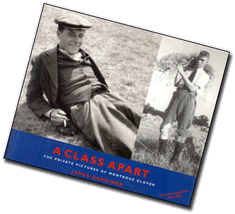
A Class Apart: The private pictures of Montague Glover By James Gardiner Chapter 2: Rough TradeIn common with many other middle-and upper-class men of his class men of his class and generation, Monty Glover was principally attracted to working-class men. Not only were mnay of them physically attractive, but they were available. It is very easy to appreciate that a body muscled by manual labour and tanned by exposure to the elements might have a strong sexual appeal. The appeal is not just sexual, however, but specifically homosexual; working men could be perceived as 'real' men, 'masculine' in a way that softer, paler (and therefore 'feminine') middle-class men could not. Homosexual literature of the late-nineteenth and early-twentieth centuries abounds with references by middle-class writers to a working class that was idealised as stronger, earthier, than their own. This idealisation was double-edged; working-class men were sometimes seen as noble savages, sometimes as just savages; dumb, anonymous sex objects. Monty's photographs illustrate (and play with) this literary mythology; in the pages that follow I have captioned with quotations which show how closely his sexual imagination followed the established pattern. 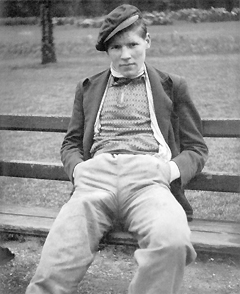
It wasn't just upper- or middle-class gay men who followed this pattern. The manual labourer was also the sexual ideal of many working-class men who themselves found it necessary or desirable to believe that their partners were in fact 'normal' — real men by virtue of their 'real' masculine occupations. To have sex with one of their own (homosexual and therefore un-manly) kind was a desperate measure to be taken when nothing else was available, and was scathingly referred to as 'tootsie trade'. This idealisation of the working man as sexual icon has persisted in our own times. In a culture where clothing is no longer a sure indicator of social class and when it is both affordable and acceptable for anyone to wear anything they like in their leisure time, many gay men from all social backgrounds choose to adopt 'butch' working-class styles. Clothing once worn as necessity, to suit a man's job, is now 'fashion'. The 'construction worker' in hard hat, torn jeans and muddy boots, the leather-clad biker, the 'clone' (an ersatz urban lumberjack in plaid shirt and jeans), the tattooed skinhead, all familiar gay styles of dress from the 1970s on, perpetuate the myth of the 'butch' working man, as potent now as it was when Monty took these photographs. It is ironic that the clothing which in his time served to highlight social divisions now serves to blur them. This function is perhaps helped by the fact that most of these modern images have been imported from a'classless' America. 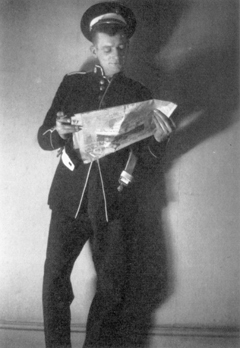
Victorian London had an extreme division between rich and poor. There was unemployment on a massive scale and many members of the poorest classes would do anything that might keep them from the door of the dreaded workhouse. Consequently, the streets of the West End were thronged with prostitutes of both sexes. Although figures estimating the number of male prostitutes are not available, a contemporary survey suggested that there were upwards of 120,000 women working the streets of London in the 1880s. Although the working classes were better off in the London of the 1930s that Monty photographed, the social structure remained pretty much the same, divisions between the classes just as clearly marked. A 'toff' was still someone to be looked up to with respect by the working classes, often as someone who might offer employment of one sort or another. It had become almost traditional for many working-class men and boys to be sexually available to any 'toff' with a disposable income. This easy availability was helped by the fact that most ordinary people were unaware that such a thing as homosexuality even existed. The word 'homosexuality' itself seldom appeared in print, the subject not considered a suitable one for discussion even within the classes that were aware of its existence. Consequently no one thought it at all odd if a gentleman took an interest in a young lad, the presumption would generally be that his motives were philanthropic. 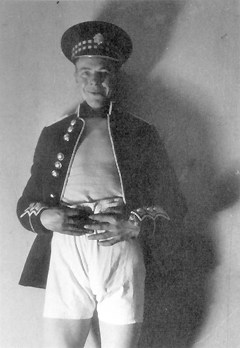
This situation still prevailed in Monty's day: whether seen as philanthropy or prostitution, most inter-class sexual contacts would still have been on a commercial footing. That prostitution played such a central role in homosexual life until relatively recent times is evident in many slang expressions dating from the nineteenth century that are still in current gay usage: 'trade' for sex, 'rough trade' for sex with a working-class man, 'rent' for prostitute; even 'gay' itself was used in the nineteenth century to refer to a (female) prostitute. Apart from the question of their availability, for many middle-class gay men the choice of working-class sexual partners meant that their sex lives could not only be kept away from their social lives (which were often centred on marriage and the family), but also reduced to a series of simple, easily regulated transactions; the exchange of money of gifts for services rendered. This structuring of sexual relationships also had its disadvantages. Physical violence and the inhibiting fear of violence were probably the least serious — and could always be eroticised and enjoyed: Oscar Wilde compared his liasons with street-boys to 'feasting with panthers'. A far greater risk, with sexual partners over whom the punters' power was merely financial rather than physical or emotional, was that of blackmail. In Monty's time public exposure as a homosexual would have meant social ruin and possibly a term in prison. 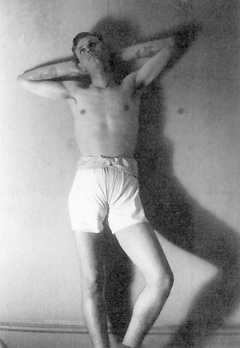
Despite this, the crowds of young men offering their bodies for sale day and night on certain streets of the West End of London found no shortage of eager 'punters'. The area around Trafalgar Square was the centre of this commerce, despite heavy policing, and Monty roamed these streets, toff with camera, photographing not only the policemen, if they were pretty enough, but the 'renters', or 'Ruffs' as he himself called them. They posed for him leaning against the low walls around the fountains, hands in pockets, hips thrust forward; barely concealing, in some cases, their sexual excitement at being photographed. And barely concealing, in some cases, their pleasure at being paid. There was a flourishing gay scene in Monty's London, despite the total illegality of all sexual contact between men. Certain public houses in central London had served as gay meeting places since the days of the notorious Molly Houses of the seventeenth century, and probably even before that. In the late-nineteenth century, the Crown in Charing Cross Road and the Windsor Castle in the Strand were well-known haunts of male prostitutes. In this century there have been scores of pubs that at one time or another served a predominantly homosexual clientele. A gay crowd would take over particular public houses until a change to a less sympathetic management or police harassment forced them to move on. In the 1930s there were at least half a dozen such pubs. The best known, The Running Horse in Shepherd Market, Mayfair has long since vanished but some, for example The Golden Lion in Soho, survive to this day, fulfilling the same function. Others, such as The Salisbury in St Martin's Lane, The Lamb and Flag in Covent Garden and The Fitzroy Tavern in Fitzrovia, survive but serving a more conventional clientele.
Several theatres and music halls also became known 'trolling grounds'. The promenade of the Alhambra Music Hall in Leicester Square had been the haunt of prostitutes of both sexes since the late-nineteenth century. Most large theatres had a promenade at the rear of the stalls where, for a small price, a standing ticket could be bought for the show. The theatre bar would remain open all through the performance and patrons making eye contact there could wander off to the convenient dark area where more intimate contact could be made. As the promenade was often extremely crowded, and theatre staff frequently gay themselves, this was a less risky business than it sounds. Other theatres popular for this additional free entertainment in the twenties included Daly's, also on Leicester Square, The Palladium off Oxford Street, with Sadler's Wells in Clerkenwell enjoying a particularly racy reputation. Some cinemas also became popular meeting places for gay men; The Biograph near Victoria Station remaining so for nearly half a century, until the 1970s. It was possible to buy a 'double' seat in the back two or three rows, and there, in the warmth and darkness, and under the cover of a raincoat folded on the lap, anything could happen. In the same way certain cafés would be colonised; the Coventry Street Corner House was popular for over a decade, especially for tea on Saturday afternoon, when the crowd was so dense that one had to get in by two o'clock in order to secure a table, and a cup of tea spun out over a couple of hours in which all the latest gossip could be exchanged, new outfits paraded, and prospective trade eyed up. Afterwards one could repair to one of the numerous private drinking clubs that dotted the Soho area. These were open from the afternoon till 11 o'clock and run strictly on a membership basis, usually a single room behind locked doors: intimate, friendly places presided over by a genial and sympathetic host or hostess who knew all the customers by name, and provided with soft-lighting and over-priced, after hours gin. One such place, a popular haunt before the last war, was Kate Meyrick's establishment above a department store in Regent Street, where for the (in those days not inconsiderable) sum of ten shillings, men wearing a black tie and dinner jacket (a strictly observed rule of the house) could enjoy a candle-lit dinner and then dance cheek to cheek on the small dance floor. In the post-war years, The Music Box in Panton Street, off the Haymarket, would be so crowded that it was difficult not to be on intimate terms with fellow members. A single room decorated in red plush, lit by pink shaded wall lights; the resident patron, a large, heavily made-up woman of indeterminate age called Lee, sat at the end of the small mirror-backed bar with her white toy poodle on her lap, her tumbler of gin kept full by her long-serving peroxide blond barman, an 'out of work dancer' wearing only slightly less make-up than his boss. Popular though these watering-holes were, frequenting them carried risks, not only that being present when the place was raided by the police (a not uncommon occurrence), but also the possibility of meeting someone from one's own work or social circle. Such a mutually compromising meeting was something to be avoided at all costs for the large numbers of closeted, and frequently married, gay men leading double lives. At least picking people up on the streets could be done anonymously, and meant that you did not have to spend time with other gay people to to identify yourself to yourself as being 'so'. It was consequently on the street, and in public lavatories, that by far the great majorityof sexual contacts were made. St James's Park, Birdcage Walk, Speakers' Corner and particularly Trafalgar Square were all well-known 'trolling' areas, and it was in these areas that Monty took his photographs. In modern times, and especially in large cities, street cruising can be more straight-forward business. Apart from anything else, it is possible for many gay men to recognise one another by the clothes they wear: gay 'uniforms' as previously mentioned, and other identifiable variations on current masculine style. In Monty's day the only men recognisable as homosexuals from their clothing were the screaming queens of the type personified by Quentin Crisp, brave creatures parading the streets of the West End covered in lipstick and floating chiffon scarves years before the Radical Drag queens of the Gay Lib era. But they were a rare breed, isolated by their blatancy from the mainstream of gay society. For most gay men who did not want to identify themselves as effeminates, clothing remained an indicator of social class, not sexual preference. Anything that might hint at effeminancy, such as suede shoes, camelhair coats and any extremes in fashion were studiously avoided; middle-class men of whatever sexual orientation aimed at looking inconspicuous, and as much like 'gentlemen' as possible. Men who wanted to meet each other on the street — the men Monty photographed — had to rely on more subtle means of recognition, such as directness of glance hopefully leading to prolonged eye contact. The group of four pictured below (in the well-known 'Meat Rack' at Trafalgar Square) might easily, from their clothing, be merely office workers enjoying a lunch-break in the early spring sunshine. What marks them out is their body language. The two men on the left both have their hands crossed over at crotch level as though concealing something; the man on the extreme right is displaying his obvious erection.
Working-class men's clothes in the 1920s and 1930s were indicators not only of class but of profession — made to be worn for hundreds of different jobs, they were much more varied than the standard all-purpose professional suit of the middle and upper classes. Monty's pictures catalogued this variety; he created a photographic, twentieth-century version of the 'Cries of London'. In doing so, he turned working-class clothing into a series of 'types', of fetishes, of uniforms. The clothing of manual labourers was often more revealing than that of other men: there was less of it. Whereas the middle and upper classes seldom appeared in public less than formally dressed (in stiff collar and tie, waistcoast, shapeless, baggy suit and a hat, even in the hottest weather), working-class men dressed for comfort, and in warm summer weather building labourers, road workers and agricultural workers would often strip down to vest or shirt, revealing well muscled arms and torso. These revelations doubtlessly had a profound effect on men such as Monty, in a time when nudity of any sort was seldom seen outside the home. The clothing of the poorest classes of unemployed street dwellers, barefoot, and in tattered shred barely definable as garments, had already been idealised and 'typified' by nineteenth-century middle-class liberals and socialists from Charles Dickens on. Although conditions for the poor in London had improved greatly by the 1930s (for example, bare feet were by then a rarity) the uniform worn by the men — shabby trousers, jacket, cloth cap and collar-less shirt, had remainded constant. In Monty's photographs this clothing now symbolised not only poverty and pathos but also possible sexual availability. It became, if you like, a uniform of desire. Monty liked to play with these images as well as document them. In his photographs, for instance, the working-class images of 'street urchin' and 'soldier' became interchangeable; they were both uniforms. He frequently took boys home to the flat he had in the late 1920s at Tackbrook Street, near Victoria Station, dressed them up, and took their photograph. There are photographs in this collection of the same boys dressed as both 'ragged boys' and soldiers; it is difficult to say which is the true identity.
He kept a well-filled 'prop box', containing bits and pieces of army uniform, a Guards tunic, sailors' bell bottoms, tunic and hat, a World War I military police uniform, jodhpurs, riding boots, and several pair of tight white cotton undershorts. He photographs all these men in the same way, crudely lit, against the same wall, a series of mug shots. He was not attempting innovative or creative photography, not trying to create Art. If this entire collection is the portrait of one man's sex life, it is in this particular sequence most clearly illustrated. This is Monty, the fetishist, keeping score. Chapter 4: A Bit of Scarlet
After the war, and back in civilian life, Monty continued to photograph soldiers, but in a different way; not as working colleagues and friends, but as anonymous objects of sexual fantasy. The gay mythology of working-class men as objects of sexual desire extended quite naturally to include the ranks of the Armed Forces; they were, after all, the same young men wearing a different uniform. One of which completely transformed not only their appearance but also their status; in uniform, and especially in time of war, ordinary working-class young men were transformed into heroes — 'Our Lads'.Any military uniform gives the wearer an air of potent and masculinity, and consequently it has a strong homo-erotic appeal. Soldiers have taken advantage of this appeal for at least the past two hundred years, and have sold their bodies for sex in order to supplement their poor pay. Xavier Mayne (in The Intersexes, Florence 1910) suggests that pay was so poor in earlier periods that prostitution became a necessity. 'The price of giving his physical beauty and sexual vigour, even if with no good-will for the act, to the embraces of some casual homosexual client brings him more money in half an hour than he is likely to receive as his whole week's pay.' Mayne also suggests that these policies were not confines to the ranks; petty officers were to be had, for more money. Also, over the years numerous cases have come to light where officers have been instrumental in introducing men from the ranks to prospective clients on a commission basis. This would not be as unlikely as it may seem if one considers that having been through the traditional upper-class educational system of public school and Oxford or Cambridge, unscrupulous officers would be much more likely to know what a queer was than some young recruit from, for example, a remote rural community, and use this knowledge to their financial advantage. 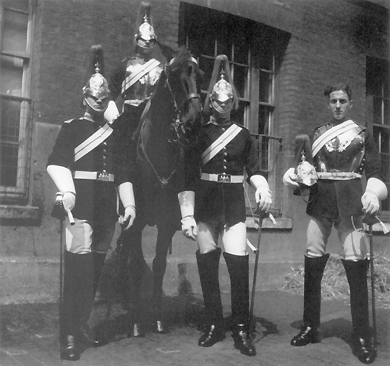 From the clients' point of view, the advantages of having a soldier lover were many. According to Mayne, he is likely to be: 'cleaner, less disease-prone. Less likely to be brutal, or a blackmailer as he has much to lose by a "row" as his patron. So as a rule, he is "discretion itself".' 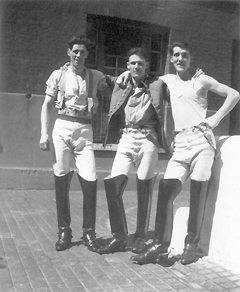
By the nineteenth century the tradition of the soldier prostitute had become widespread, and all garrison towns and ports had pubs and well-known 'trolling' areas where soldiers and their prospective clients could meet. Xavier Mayne noted that '… one only had to stroll around Portsmouth, Aldershot, Southampton … to find the soldier prostitute in almost open self-marketing … on any evening, the street corners, or the promenades of the Music Halls and cheap theatres of London and other cities, show the fine flower of the British Soldier prostitute, dressed in his best uniform, clean shaven, well groomed and handsome, with his Anglo Saxon pulchritude and vigour, smilingly expectant.' Apart from such casual meetings, soldiers were sometimes involved in organised forms of prostitution. There was at least one known procuress operating from a confectioners shop near the barracks in Regent's Park, and soldiers were found to have been working along with post Office messenger boys in the homosexual brothel in Cleveland Street which became notorious when exposed in 1889. When one of the defendants in the case, Jack Saul, himself an ex-soldier, published his (undoubtedly ghost-written) memoirs in 1881 under the title The Sins of the Cities of the Plain, or the Recollections of a Mary-Ann, (a masterwork of Victorian pornography), he stated: 'This is the experience of all the men of my regiment, and I know it is the same in the First, The Blues, and every regiment of the Foot Guards.' The tradition of male prostitution in the Armed Forces, and particularly the London based Guards Regiments, lasted until relatively recently. Into the early 1970s the Guards Regiments had a well-founded and long standing reputation for being readily sexually available; they were 'TBH' ('to be had'). For the lovers of soldiers (or to give them their correct name 'philostratists' — from the Greek naturally), the Guards Regiments had particular appeal: with their dashing uniforms of scarlet, black, white and gold, tight tunics, tighter trousers and knee-high shiny boots, they were every uniform fetishists dream come true. In fact, having sex with a tall, blond young guardsman was the most popular romantic fantasy for gay men of Monty's time, a fantasy made all the more potent by the fact that for a few pounds it might become reality. The neighbourhoods around the Guards' barracks — the parks and squares of Knightsbridge and St James's — were well known trolling grounds, and many of the pubs in the Knightsbridge area became notorious as haunts for gay men looking for 'a bit of scarlet' (nineteenth-century slang for sex with a soldier). The Grenadier on Wilton Place and Tattershall's Tavern on Knightsbridge Green were among the best known. Over the years, Monty rented several flats in the area. For a few years in the 1930s he lived in Buckingham Gate opposite the Wellington Barracks; he even managed — one cannot imagine how — to get inside the barracks and photograph the Guardsmen both in and out of uniform.
'All the nice girls love a sailor As Hetty King's turn of the century music-hall song implies, nice girls (and boys) have always found a sailor's uniform irresistible. The popularity of the Jolly Tar in gay mythology stems from a double fantasy; first that long periods at sea away from feminine company accustoms sailors to the idea of turning to their own sex for physical relief (all sailors are really homosexual); secondly, that enforced abstinence at sea makes them ready for anything, even a homosexual, once they get ashore (all sailors are 'real men'). The connection between homosexuality and the Royal Navy was so widely accepted that even Sir Winston Churchill dismissed 'Naval Tradition' as being little more than 'rum, buggery and the lash'. At the turn of the century, Xavier Mayne hazarded to guess that '…every sailor in two or three is homosexual,' although this was probably wishful thinking. As 'trade' Mayne commended them as being 'less mercenary' than guardsmen. In later years, especially the 1950s, the Merchant Navy frequently provided a comfortable milieu for many homosexuals fleeing from the inevitable police purges which followed in the wake of homosexual scandals as the Montagu affair of 1954. Every vessel had its quota of 'Sea Queens' working as stewards. All sailors, Merchant Navy or Royal, enjoyed a reputation for being open minded regarding sexual matters, and for Monty and his contemporaries, the sailor's uniform signalled sexual promise. This uniform in itself, the torso tightly fitted by a tunic topped off with the famous collar saucily nicknamed a 'dickie' (the touching of which was supposed to bring good luck), trousers close over the hips, flaring out to bell-bottoms and opening horizontally via a buttoned (and easily unbuttoned) flap, was flattering to the figure and homo-erotic in the extreme. Add to this the fantasy of muscular tattooed forearms and a body kept hard and fit clambering up ladders and swabbing decks, and you have an image of raunchy masculinity that few nice girls, and boys, could resist. Unsurprisingly, photographs of sailors abound in this collection, snapped by Monty: caught casually and often unawares in public places, or posed portraits of friends, tricks and lovers.
|
|
|
|
Created: November 12, 2003 Last modified: November 13, 2003 |
 |
Commercial Sex Information Service Box 3075, Vancouver, BC V6B 3X6 Tel: +1 (604) 488-0710 Email: csis@walnet.org |